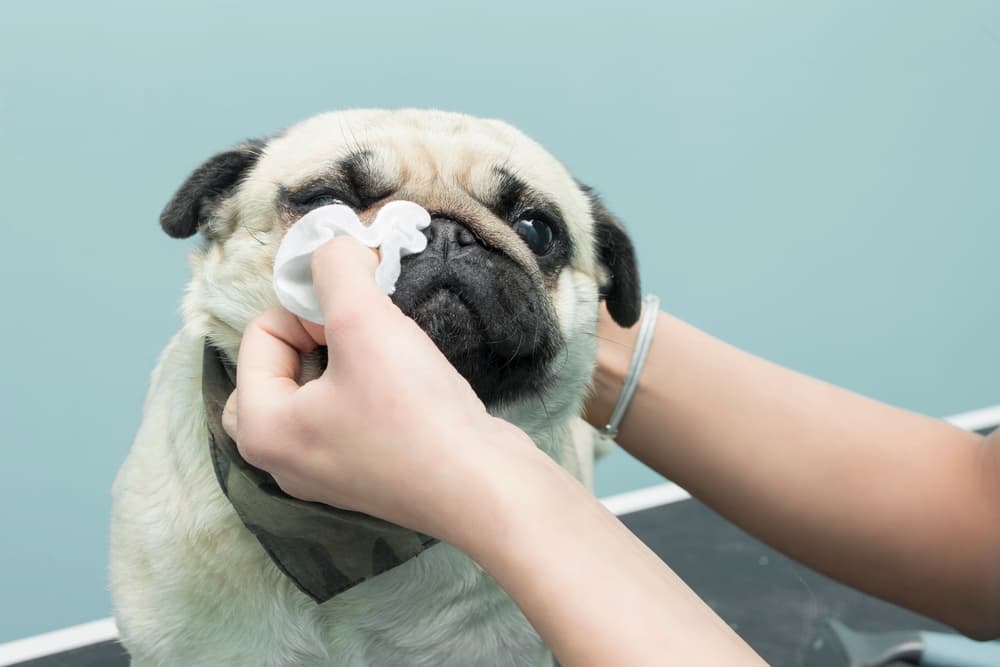
Corneal Ulcers

Our guide has been authored by qualified veterinarians, but should not be taken as substitute for medical advice or professional veterinary consultation. If your pet displays any unusual symptoms, we strongly advise seeking guidance from a veterinarian
Understanding Corneal Ulcers in dogs
A corneal ulcer in dogs refers to an open sore or erosion on the surface of the cornea, which is the transparent outermost layer of the eye. The cornea plays a crucial role in protecting the eye and maintaining its clarity. When an ulcer forms, it disrupts the smooth surface of the cornea, resulting in discomfort and potential vision problems. Additionally, corneal ulcers can become complicated if they become infected, leading to further complications and potential damage to the eye.
Corneal Ulcers's Causes: Uncovering Triggers
- Trauma to the eye – this can result from scratches or foreign objects, such as thorns, debris, or dust particles, coming into contact with the cornea. Dogs may get injured during play, fights, or accidents, or due to exposure to environmental hazards.
- Infections – bacterial, fungal, or viral infections can lead to corneal ulcers in dogs. Viral infections, such as canine herpesvirus or canine adenovirus, can also cause ulcers.
- Dry eye (Keratoconjunctivitis sicca) – dogs with inadequate tear production may develop dry eye, leading to a dry and vulnerable cornea. This can make them more susceptible to corneal ulcers due to reduced lubrication and protection.
- Foreign bodies – when foreign objects, like grass seeds, plant material, or eyelashes, become lodged in a dog’s eye, they can cause irritation and damage to the cornea, potentially leading to ulcers.
- Brachycephalic syndrome – breeds with shortened noses and prominent eyes, such as Bulldogs, Pugs, and Shih Tzus, are prone to developing corneal ulcers due to their unique facial anatomy. The abnormal placement of the eyes and eyelids can result in corneal exposure and increased susceptibility to injuries.
- Chemical irritants – exposure to certain chemicals or irritants, such as cleaning products, pesticides, or shampoo, can cause chemical burns to the cornea, resulting in ulcers.
 Recognizing Corneal Ulcers: Signs and Symptoms
Recognizing Corneal Ulcers: Signs and Symptoms
- Eye redness: the affected eye may appear red or bloodshot.
- Eye discharge: an increased production of tears from the eye.
- Excessive blinking or squinting: due to pain or discomfort.
- Cloudy or opaque cornea
- Swollen or puffy area around the eye
- Sensitivity to light: Dogs with corneal ulcers may be sensitive to bright light and may try to avoid it.
- Eye rubbing or pawing: in an attempt to alleviate discomfort.
- Behavioral changes: Dogs in pain may show signs of irritability, restlessness, or decreased appetite.
 Corneal Ulcers Diagnosis: How it's Identified
Corneal Ulcers Diagnosis: How it's Identified
- History and physical examination, including an assessment of the dog’s eyes, to check for any obvious signs of corneal ulceration.
- Fluorescein staining – a common diagnostic test used to identify corneal ulcers. A special dye, called fluorescein, is applied to the surface of the eye. If there is a corneal ulcer present, the dye will adhere to the damaged area, making it visible under blue light.
- Schirmer tear test – this test measures the quantity of tears produced by the dog’s eyes. Low tear production can contribute to the development of corneal ulcers.
- Ocular pressure measurement – the veterinarian may use a tonometer to measure the pressure within the eye. This test helps rule out conditions like glaucoma that could be contributing to the ulcer.
- Detailed examination – the veterinarian may use an ophthalmoscope or slit lamp biomicroscope, to examine the ulcer in detail. This allows for a closer evaluation of the size, depth, and location of the ulcer, as well as any associated inflammation or secondary complications.
 Treating Corneal Ulcers: Options and Approaches
Treating Corneal Ulcers: Options and Approaches
- Topical medications – ophthalmic antibiotic eye drops or ointments to prevent or treat infection associated with corneal ulcers.
- Pain management – topical ophthalmic analgesics or systemic pain medications to alleviate discomfort and promote healing.
- Elizabethan collar – dogs with corneal ulcers are often fitted with Elizabethan collars to prevent them from scratching or pawing at the affected eye.
- Protective eyewear – in some cases, a veterinarian may recommend the use of protective eyewear such as a specialized contact lens or a temporary protective soft contact lens to shield the cornea and aid in healing.
- Surgical intervention – severe or non-healing corneal ulcers may require surgical intervention. Procedures such as corneal debridement (removal of damaged tissue) or grafting may be necessary to promote healing and prevent complications.
Corneal Ulcers: Surprising Facts

Corneal ulcers are relatively common in dogs, with a prevalence rate estimated to be around 5-10% of all canine ophthalmic conditions.

If left untreated, corneal ulcers can worsen and lead to corneal perforation, which is a serious condition requiring immediate veterinary attention and surgery.

Approximately 50-70% of corneal ulcers in dogs are attributed to trauma from scratches, foreign objects, excessive rubbing, or accidental injury to the eye.
 Vet's Tip: Dealing with Corneal Ulcers
Vet's Tip: Dealing with Corneal Ulcers
Be sure to follow your vet’s instructions on how to apply eye drops or ointments. Wash your hands before and after administration to prevent the spread of infection. Use a gentle touch and avoid touching the eye directly with the dropper or tube. In addition, your vet may provide specific instructions on how to clean the eye or remove any discharge. Use a clean, damp cloth or sterile saline solution as directed. Do not use any products without your vet’s approval, as some may worsen the condition. Always make sure your dog wears an e-collar to prevent them from traumatizing the eye.




Price Tag

Latest in Research and Treatments
Veterinary ophthalmologists at Cummings Veterinary Medical Center have started using corneal crosslinking—a treatment borrowed from human medicine—to help spare dog eyes or avoid surgery. The result is that the cornea becomes a lot more rigid and therefore, less susceptible to injuries. Crosslinking may also improve surgical options for some dogs. Since crosslinking helps make the corneal tissue resistant to degradation and has antibacterial and antifungal effects, it allows veterinarians to use more desirable, transparent grafts instead.
dogs breeds Prone to Corneal Ulcers
Did you know?
Enrolling in Animalia Pet Insurance
while your pet is healthy is a wise decision.
Waiting until a disease develops means it won't be covered.













